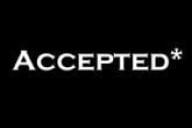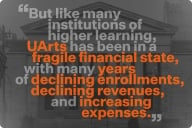You have /5 articles left.
Sign up for a free account or log in.
First they chopped off our hands. Figuratively, of course. The U.S. Department of Education, over the past decade, has made it clear that it expects accrediting agencies seeking recognition to judge student learning and institutional quality on the basis of rubrics, metrics and measured student learning outcomes. This, rather than on the basis of peer review -- the intense, direct interaction with students and faculty members that enabled site visitors to observe directly the nature, quality and level of learning taking place at an institution.
By now, there is wide recognition that relying on these proposed quantitative measures has weakened accreditation, with collateral damage. Thus, colleges that were focused on a financial bottom line rather than on student learning found it easy to produce numbers that satisfied quantitative guidelines, but said little or nothing about the learning taking place.
Sadly, the focus on such proxies remains. Graduate earnings, for example, are still being proposed as an indicator of quality. Low student debt and gainful employment are other proxies that say nothing about actual learning -- nothing about rigor, challenge, intellectual growth or any of the myriad outcomes that characterize the transformation we associate with a postsecondary education. Because these outcomes cannot be described quantitatively, they have been forced off the accreditation agenda.
Resistance proved fruitless. One small agency, facing the federal panel that recognizes accreditors in 2007, argued strenuously that its own intense focus on critical thinking and scholarship was more effective than the recording of quantitative measures. To no avail -- the agency’s recognition depended on compliance. Ever since, it has been requiring its accredited schools to gather irrelevant numerical outcome data in addition to its continued emphasis on qualitative outcomes.
So if accreditation has been falling down on the job, we now know why. Hopefully this will change with the forthcoming reauthorization of the Higher Education Act. Perhaps this paper -- and others like it -- will engender a new attitude in fashioning legislation and regulation. Accreditors will no longer have to be contortionists, and we should see a renewed emphasis on the searching and effective peer review.
The Peer Review -- A Primer
Peer review is based on site visitors who collectively have the experience and expertise to examine an institution comprehensively. A brief illustration of the thinking of a site visitor examining a college’s laboratory program will help explain peer review.
The visitor would probably think about the number of students working at a piece of equipment. If there are more than two, he will watch to see whether all are engaged -- building, adjusting, measuring, changing -- or whether one person is active and the others are simply taking notes.
The visitor will also note whether the lab instructor is sitting behind a desk or whether she is an involved part of the learning process -- helping, challenging, explaining and working with different groups of students throughout the period. The experienced peer reviewer will watch what happens near the end of the period. Will students hand in their assignments and leave -- or will they continue to work with the equipment to see what else they can learn?
These and other observations will contribute to the in-depth and comprehensive site visitors’ report, which will prove invaluable in enabling the accrediting agency to judge the quality of the institution and help its officials address deficiencies in an effort to improve.
On the other hand, an emphasis on quantitative metrics (amount of money spent on lab equipment, number of students served per day…) reveals little of the reality of a school or its lab.
Are There Alternatives to Traditional Accreditation?
Possibly, but those proposed are so far untested and unverified. Ideas that do have a “feet on the ground” validity somehow turn out to look like accreditation.
It’s helpful to visualize what an alternative strategy for the assessment of colleges and universities might look like. Clearly we would want to examine each institution against its own mission, and to do so we would need an understanding of the student demographics and the kind of learning and teaching taking place there. To be able to determine whether students are progressing successfully, we would certainly want to have a discipline expert in our group, and we would judge the institutional resources to ensure that a supportive educational atmosphere results. We would judge the faculty’s background to ensure that teachers have requisite content knowledge, and we would examine financial and other considerations that make an institution run smoothly.
We shouldn’t be surprised that this approach resembles accreditation. Accreditation has been honed by well over a century of practice at more than 6,000 institutions in the United States, and increasingly, throughout the rest of the world.
Licensure and certification pass rates have been proposed as indicators of quality for colleges offering occupational and vocational programs. But we must consider that if students learn only what is needed to pass a licensure exam, their preparation could be obsolete by the time they graduate. Everyone needs to learn how to learn, to adapt, to cope with changes in a given field, and colleges whose programs are limited to enabling students to pass licensure exams cannot be deemed quality. A far more intense examination is called for, and that’s of course the role of the peer review and accreditation.
Examining Proposed Modifications to Traditional Accreditation
(i) Should There Be More Public Member Participation?
There are public members who add immeasurably to accreditation decision-making meetings and just as many who do not. It’s also important to recognize that public members do not represent any special sector of the American people, bring no special expertise and offer no unique perspective. They are representatives from the public, not of the public.
Agencies have discovered that finding a public member prepared to serve, vetting him or her, gathering relevant documents, ensuring that the broad membership approves of this person, and training him or her constitutes a burden that sometimes is not commensurate with the benefit.
Until there is clear, experimentally validated evidence that additional public participation is warranted, no legislative or regulatory change to the current requirements should be made.
(ii) Should Accreditation Be More Transparent?
Accreditation is not a secretive, mysterious process, and on occasion legislators and journalists have been invited to participate in site visits to see for themselves. At a college preparing for a visit, dozens of people are involved. At the visit itself, dozens of others participate. This broad participation is not a recipe for secrecy and a lack of transparency.
Confidentiality, however, is important for decision making, because this enables institutions to be open and forthright with site visitors in describing their limitations. In fact this is a characteristic that distinguishes between accreditation and regulation. Because schools know their internal confidential documents and problems will not be widely published, they trust accreditors. This is why regulation rarely, if ever, leads to disclosure or improvement while accreditation does.
Transparency is neither disclosure nor exposure. Complete disclosure of, for example, all the part numbers of an automobile says nothing to the consumer about its functionality. Nor is transparency exposure. Releasing accreditation reports about institutions to the public ensures that schools will hesitate to discuss their limitations and challenges; it will occasion site visitors to write defensively and result in a distorted picture of an institution being presented to the public.
Transparency properly relates to the needs of the public and makes it possible for members of the public to receive the information that will make a difference, without at the same time compromising the accreditation process.
This is worth reiterating. The strength of accreditation lies in the fact that colleges are prepared to disclose, to be frank, to share limitations, to open the door to examination of all aspects of their activity, including the most embarrassing situations that might subject them to disfavor.
Accreditors are not regulators. Regulators discover only what they happen to see during their visit. Trusted accreditors discover everything.
(iii) Should There Be a Common Language?
Every step taken to unify different accrediting agencies is a step toward compromising the very diversity that makes American higher education so strong. Of particular concern is the fact that anything that is defined as common practice inevitably slides into becoming required practice. American higher education flourishes partly because there is competition; there are differences and there is an opportunity to examine the impact of different approaches in different situations.
We must ever be alert to the dangers of a unitary, “ministerial” form of higher education. Our diversity, competition and freedom to try new and different things should never be limited or compromised.
Alignment is not an overriding imperative, nor is comparability. Sometimes these considerations are helpful, but they should not be permitted to lead to a homogeneity that precludes responsible change and innovation in accreditation.
(iv) Should Accreditation Be More Proactive to Innovation?
Most so-called disruptive innovations are focused on inputs. MOOCs, experiential learning, competency-based education and technology of all kinds speak largely to different means of delivering education -- that is, to inputs.
Calling for innovation says little about quality or outcomes, and this is precisely why accreditation is so necessary in fostering innovation. It is only if an innovative approach is measured against standards, and performs well against a template of excellence, that we can agree that learning is taking place. Innovation, without the careful review associated with accreditation, risks harming students because of deficiencies that can emerge after graduation.
An innovation that does meet the standards of an appropriate accrediting body moves much more quickly and effectively into the mainstream than would otherwise be the case. In this respect accreditation can be seen to be fostering innovation.
(v) Should There Be Different Levels of Accreditation?
Perhaps. At the moment, standards operate to establish a floor, delineating the minimum quality necessary for institutional or program acceptability. It might be desirable to create gradations of accreditation status. Will such gradations make a difference? No one can tell, and careful experimentation is called for before any permanent changes are made.
Accreditation as Gatekeeper to Student Financial Aid
Accreditation as gatekeeper has become a target, and it’s important to outline the reasons that keeping this feature is extremely important to a well-functioning postsecondary educational system.
(i) Maintaining Order and Fostering a Culture of Improvement
The gatekeeping function helps create a sense of order in American higher education. All reputable institutions are recognized by agencies that, in turn, satisfy the regulations of the Department of Education and the standards of the Council for Higher Education Accreditation.
There are problems with this structure, but because of the role of Congress, the tendency of the Department of Education to overreach can be checked. Every reauthorization of the Higher Education Act has helped remind the department that it serves education; it does not guide or control it.
Now visualize a situation in which student financial aid would flow to colleges and universities whether or not they are accredited.
Since they would remain eligible for aid without accreditation, elite institutions with strong, well-established reputations will not find it necessary to seek to be accredited. Some might join together in an exclusive club, but there is not likely to be a pretense of seeking to improve or to adhere to any external standards. Such schools will continue to be able to attract excellent students and donor support on the strength of their reputations alone.
The very lowest-performing colleges in the country are not likely to seek accreditation, either. At best, some will gather to create an accrediting body with indifferent standards, as a marketing feature. Lost in all of this will be the culture of improvement that is integral to accreditation. Schools do respond to site visit recommendations, and if site visit reports are not as incisive and comprehensive as they used to be, they are still effective in charting a path for improvement.
(ii) Diploma Mills Will Proliferate
As noted, the gatekeeper function ensures that all reputable schools seek accreditation from agencies that have Education Department recognition. Indeed, the department maintains a list online of all schools accredited by recognized agencies. Diploma mills are not on this list, nor are they eligible for student financial aid. If accreditors are no longer gatekeepers, many legitimate schools will not seek accreditation yet will receive financial aid. So will diploma mills. People who create diploma mills are extremely resourceful, and will be able to meet any paper requirements needed to become eligible for SFA funds. It’s only accreditation as gatekeeper under the Education Department that prevents them from doing so now.
Further, without the department's recognition function, there will be nothing to prevent a dishonest operator from creating an accrediting body (such as the “Northeast and Southwest Association of Colleges and Schools”), listing several hundred legitimate schools as being recognized by this association, and adding a number of diploma mills to its list.
True, this fraudulent accrediting body would not be admitted to the Council for Higher Education Accreditation, but the unsophisticated and unsuspecting enrollee in a diploma mill would not know the difference. And if necessary, the same printing press that created schools out of air, and accrediting agencies out of fairy dust, can readily create a CHEA-like body as well.
(iii) Transfers Will Be More Difficult
Colleges hesitate to accept transfers from community colleges and weaker institutions without reassurance from an external body. As difficult as it is now for students to transfer credits, it is still possible to move from a weak accredited school to a stronger one. In the future, with no recognized accreditor to offer lose control over their practices, colleges will be free to institute arbitrary and unduly restrictive transfer policies.
(iv) Innovation Will Be Stifled
As noted above, innovation makes sense only if it is responsible and consistent with the standards of higher education. It is useful to students only if their efforts in an innovative mode are subsequently recognized by conventional schools and employers. Accrediting agencies, even at the risk of being accused of being obstructionist, have insisted that innovation not result in any diminution in the quality of education.
Innovators seek accreditation, because once approved, a changed structure, strategy or delivery mechanism can be assured of acceptability and wide implementation. Without a broad-based, unified accreditation structure, tied together by a gatekeeping function, acceptance of innovation will become more difficult.
(v) Public Protection
There are many emerging areas of public activity, particularly in the field of health services, where there is no government oversight and much potential for public harm. Access to financial aid encourages accreditors to seek federal recognition. This is why responsible educators and practitioners in a given field organize themselves around an accrediting structure that will meet Education Department standards. This helps create a level of assurance of quality, which serves the public.
The advent of the Internet and the ease with which false and misleading structures can be created makes it important to keep accreditation intact, particularly since there have been no structured experiments and pilot programs to examine proposed alternatives. Conversation is healthy, but nothing should be done to dismantle the existing gatekeeping/accrediting relationship until it is clear that a replacement is at least as good as the original.








